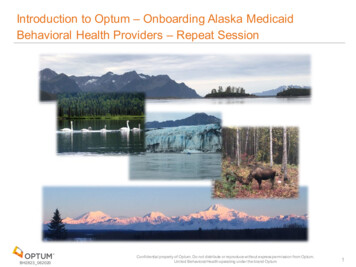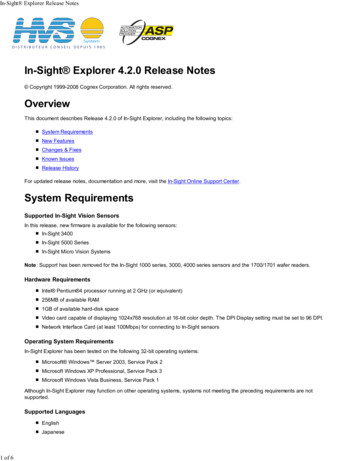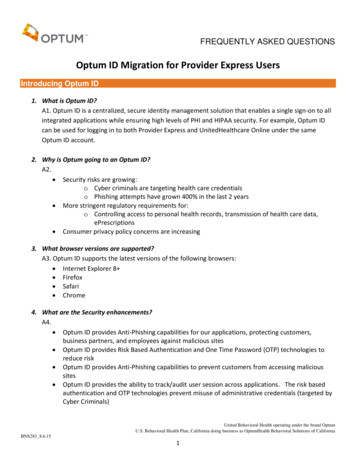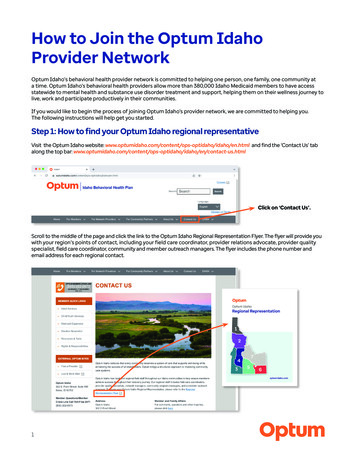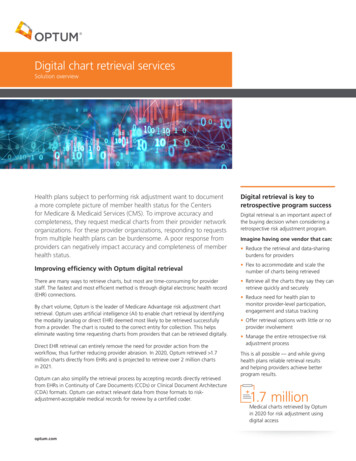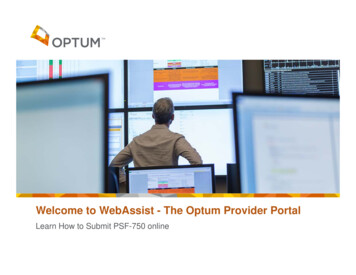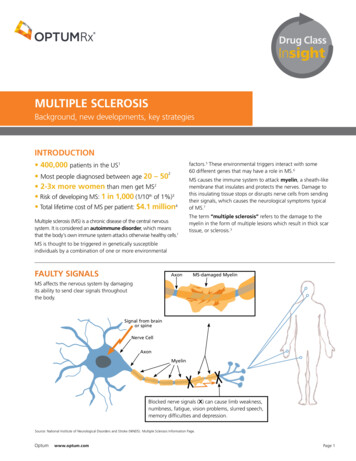
Transcription
Drug ClassInsightMultiple SclerosisBackground, new developments, key strategiesIntroduction 400,000 patients in the US12 Most people diagnosed between age 20 – 50 2-3x more women than men get MS2 Risk of developing MS: 1 in 1,000 (1/10th of 1%)3 Total lifetime cost of MS per patient: 4.1 million4Multiple sclerosis (MS) is a chronic disease of the central nervoussystem. It is considered an autoimmune disorder, which meansthat the body’s own immune system attacks otherwise healthy cells.1factors.5 These environmental triggers interact with some60 different genes that may have a role in MS.6MS causes the immune system to attack myelin, a sheath-likemembrane that insulates and protects the nerves. Damage tothis insulating tissue stops or disrupts nerve cells from sendingtheir signals, which causes the neurological symptoms typicalof MS.7The term “multiple sclerosis” refers to the damage to themyelin in the form of multiple lesions which result in thick scartissue, or sclerosis.3MS is thought to be triggered in genetically susceptibleindividuals by a combination of one or more environmentalFaulty signalsAxonMS-damaged MyelinMS affects the nervous system by damagingits ability to send clear signals throughoutthe body.Signal from brainor spineNerve CellAxonMyelinBlocked nerve signals (X) can cause limb weakness,numbness, fatigue, vision problems, slurred speech,memory difficulties and depression.Source: National Institute of Neurological Disorders and Stroke (NINDS). Multiple Sclerosis Information Page.Optumwww.optum.comPage 1
Multiple Sclerosis Insight ReportWho gets MS?Diagnosing MS is difficult for several reasons. No single laboratory test can prove or rule out the presence of MS and inits early stages, symptoms may be completely invisible. Often people can have symptoms that are erratic and very difficultto interpret.6 Still, there are some patterns: F emales are 2-3 times more likely to be diagnosed1 M S mainly affects young adults – first diagnosis typically between ages 20-501 M S is not contagious or inherited (although certain genetic traits may make one more susceptible)1Common types of MSNameCharacteristic symptomsRelapsing-Remitting(RRMS) Short duration (days to months) May remain symptom-free for months or yearsSecondary-Progressive(SPMS) Slow, steady progression – with or without relapses Relapses do not fully remitRRMS: 85%Primary-Progressive(PPMS) Steady worsening from the start Do not have periodic relapses and remissionsPPMS: 10%Progressive-Relapsing(PRMS) Steadily worsen from the onset Flare-ups – with or without remissions – are also presentPRMS: 5%Most of the 85% diagnosed with RRMSwill eventually transition to SPMSSource: Multiple Sclerosis Association of America. About MS. 2014.TreatmentThere is no cure for multiple sclerosis at this time.1MS treatments are called Disease Modifying Therapies, or DMTs.5 While DMT medications do not cure MS, they do helpreduce the severity and frequency of flare-ups and may delay disease progression, delay disability, and increase longevity.3This chart shows currently approved DMTs:FDA-approved DMTsSelf-InjectedAvonex Betaseron Copaxone Extavia Rebif Intravenous (IV)infusionNovantrone Tysabri OralAubagio Gilenya Tecfidera Each therapy has its pros and cons. All of the approved DMTs demonstrate varying abilities to reduce relapserates, slow disease progression, and slow the progression of disability. Each drug also carries the risk of side effects ranging from relativelyminor flu-like symptoms and depression to difficulties at the site of injection,but ranging upward to the risk of cardiac disease, leukemia and severeliver damage. Different results can be caused by the type of drug, dosage and how it isadministered. Stronger drugs may offer greater effectiveness but may alsopose greater health risks. Additionally, the effectiveness and side effects ofeach drug may vary from one patient to another, so treatment needs tobe individualized. Since the oral medications are so new, there is limited long-term safetydata. Therefore, their exact place in therapy is still not known for sure.Source: Multiple Sclerosis Association of America: About MS, 2014.In summary, MS is a potentially debilitating disease with high treatment costs. But early treatment, paired with robustmanagement strategies to ensure efficient medication use, can help employers successfully control the costs of MS andretain the services of valuable employees.Optumwww.optum.comPage 2
Multiple Sclerosis Insight ReportTHE HIGH COST OF MSMS is a chronic disease that is typically first diagnosed during a patient’s most productive working years (20-50).1As a result, employers face huge potential direct and indirect costs.11Per-member medical costs for MS patients are much higher than for those who do not have MS — up to 30,000per year, including medical care and prescription drugs.4 When we isolate just at the top 1 percent of MS patientsby severity, the per-patient cost surges to over 66,000 per year.12By far the greatest proportion of spending for MS comes from the DMT patients must take to keep MSfrom progressing in severity.Total spending for MS5% 1%MS pharmacy spendingPrescriptions: 73%Outpatient: 21%Inpatient: 5%95% of all MS pharmacy spendingcomes from DMTs21%EmergencyRoom: 1%73%5% of total Rx spend Migraine agents Anti-depressants Narcotic analgesics Corticosteroids Anti-spastics Anti-convulsants NSAIDS AntianxietySource: Supplement to Journal of Managed Care Pharmacy Vol. 19, No. 1-a January/February 2013. Perspectives for ManagedCare Organizations on the Burden of Multiple Sclerosis and the Cost-Benefits of Disease-Modifying Therapies.Adherence can be a problemMaintaining DMT treatment consistently is important – even when the patient is not experiencing any symptoms.9However, MS treatment adherence is a concern. Looking across multiple DMT regimens, almost half of MS patients stoptaking their medication at some point.10Nonadherence is both dangerous and expensive. Even without symptoms the disease can still be progressing andcausing damage to the nervous system.11 Nonadherence can also lead to relapses costing up to 13,000 per episode,which contributes to the high overall medical claims for MS patients.When compared with medical costs of other chronic conditions such as diabetes, chronic obstructive pulmonarydisease, (COPD) and coronary artery disease, MS ranked among the most costly, second only to congestive heart failure.11The good news is that MS patients who begin DMTs early and maintain them over time show lowerabsenteeism and lower overall medical costs.10Average MS adherence rateAdherent: 57%Non-adherent atsome point: 43%Optumwww.optum.comPage 3
Multiple Sclerosis Insight ReportPrimary Cost driversPrice inflationAfter being relatively stagnant, with few new or improved treatments for some years, MS is showing signs ofcoming to life as a therapeutic category. MS is one of three highly-utilized classes with spending growth greaterthan 10 percent per year, primarily driven by recent innovations.13 [See also, “New MS drugs.”]Overall, MS drug spending is driven more by higher drug costs than by increased utilization. Not only arenew products priced higher, but prices for existing DMTs have risen rapidly.In 2010 the price for the first-ever oral DMT, Gilenya, was set at 4,000 per month.14 That price was up to 50 percentabove the established DMTs at that time.Note in the chart below, that in every case, the less expensive the drug was in 2010, the higher thepercentage increase by 2014. More expensive drugs made do with smaller increases, yet the overall effect is to pullthe price for this basket of drugs up by a collective 67 percent:Price increases for 5 popular DMTsAverage 4-year increase: 67%Rebif 6,000 5,500 82%Avonex 5,000Betaseron 75%Copaxone 60%Gilenya 45% 82% 4,500 4,000 3,500 3,000 2,5002010 010 prices: Brass and Ivory: Life with MS and RA. d-at-4000month-30-50.html.2014 prices: GoodRx.com. Accessed 06.26.2014.Other cost DriversAdd-on drug therapiesAmpyra (dalfampridine) is used together with a DMT to improve walking distance in MS patients.15 Adding Ampyrapushes the average cost of MS therapy to 78,000 per year for about ten percent of OptumRx MS patients.16No genericsAt the present time there are no generic DMTs. Hopes for a generic version of Copaxone (currently the top-selling MSdrug) by the spring of 2014 have dimmed as the parties continue to struggle in court.17 Beyond Copaxone, generics willnot supply additional price relief in this category until at least 2016.18A new blockbuster?The most recent oral DMT, Tecfidera (dimethyl fumarate) has showed good safety and effectiveness, but with less severeside effects than existing DMTs.13 Analysts predict that Tecfidera will become the most commonly used MS drug over thenext five or so years, with sales as high as 6 billion by 2020.19Optumwww.optum.comPage 4
Multiple Sclerosis Insight ReportWhat's next in MS treatment?The DMTs that have been in use since the 1990s, as well as the more recent oral DMTs, are designed to prevent nerve damageand slow the progress of the disease; but they are not a cure. Once MS destroys the myelin on a nerve, it cannot be regenerated.5Recently, there is new progress toward therapies that may work to reverse the damage caused by MS. By far the most excitingpart of this new work is taking place in the field of human neural stem cells.Studies in both animals and humans are underway and the results have been very encouraging.20, 21 Mice severely disabled bya condition similar to MS were able to walk and run less than two weeks following treatment with human neural stem cells.In addition, even six months after their injection their functionality was still strong, even though the injected cells had beeneliminated long before.20, 21These are very early results, of course. Many promising research leads have faltered in the transition from animal to humanstudies. That is why it is especially notable that the FDA has approved phase 1 trials in human subjects to study the use ofneural stem cells in the treatment of MS.22 In addition, a larger phase 2 study is underway that involves MS patients from theUK, Italy, the US and Canada.22As research momentum builds there is growing optimism. Some researchers believe that these neural stem cell projects couldlead to successful new treatments for MS in as soon as three to five years.22Reversing MSThis illustration shows how human neural stem cells were used to repair damaged myelin in mice.MS impairs nerve functionby damaging myelin, aninsulating layer that surroundsnerves. Mice with MS can’tmove well.DamagedMyelinHuman neural stem cellsinjected into MS micestimulate the mouse’s owncells to repair the damage.RepairedAxon MyelinNerve cell function is restored.MS mice can walk and run.Source: Scripps Research Institute. Stem cell therapy shows promise for MS in mouse model. May 15, 2014. Available at: 5123301.htmOptumwww.optum.comPage 5
Multiple Sclerosis Insight ReportA comprehensive approach to managing MSSynchronized Specialty Pharmacy Optimizes ResultsThe combined size and expertise of Optum and UnitedHealthcare extends across all benefits. We leverage multiplestrategies that promote better health outcomes and lower total health care costs while helping members make thebest use of their benefits.Total Cost ControlTotal Care Coordination Drug cost and choice One care team Right benefit (medical or pharmacy) Physician coordination Appropriate use Adherence supportWhat we doOur total approach to MS combines a robust drug managementstrategy together with clinical management and adherence programs: Prescription Drug List (PDL): Uses cost-sharing tiers to encourage useof preferred treatments.– Exclusions: Keep the focus on drugs that offer true clinical andeconomic value. We currently exclude Extavia . Utilization Management Tools–S upply limits: Help limit wasted medication.–P rior authorization: To ensure prescriptions are fora covered condition.–S tep therapy: To promote the use of clinically similar, morecost-effective medications. P rice protection: Negotiated arrangements with manufacturersto lock-in drug prices.We automatically apply these strategies for our Fully Insured clients who combineUnitedHealthcare medical policies with pharmacy benefits administered by OptumRx.We encourage, but do not require, our UnitedHealthcare and OptumRxcarve-out ASO customers to adjust their plans in this way. Consult with yourrepresentative for details.Optumwww.optum.comPage 6
Multiple Sclerosis Insight ReportTotal MS Care CoordinationWe use the power of synchronization to surround MS patients with the powerof ONE. ONE streamlined member experience comes from ONE commonplatform supporting ONE care team to deliver lower cost and better health.ONE ExperienceONE SystemONE Team S treamlined touch points fora better experience 360 total health view of eachmember (Medical, Rx, lab, wellness) Up to 30 days faster engagementon health and savings opportunities 1 to 1 consultations Real-time data vs. monthly feeds Reducing total costs by promoting lowercost medications, mail service, and caremanagement programs 64% of health and savings opportunitiesdriven by pharmacy data Pharmacists, nurses, case managersand member services shareinformation and expertise. Depression screening and referrals M aking the most of interactions by engagingon health and savings opportunitiesDriving Value with Pharmacist Medication ConsultsMS patients who are signed up for our intensive Clinical Management Program (CMP) have a direct, one-to-one relationshipwith one of our specialty pharmacists or nurses. They can call directly to discuss issues around their medication regimen,including access to their medications and managing their side-effects.All of our members have access to pharmacists who are embedded on the care team. They can conduct medicationconsults with consumers identified as “at risk.” Pharmacists use integrated tools to view each patient’s medical historyand automatically calculate their personal pharmacy risk score along multiple factors. They can also receive automatedalerts for potential cost savings by switching to lower-cost alternatives.Medication-related consult opportunities by categoryMedication Non-Adherence 11%Medication Gaps 6%CostSavings49%DrugSafetyConcerns34% Drug Safety Concerns Cost Savings Medication Gaps Medication Non-AdherenceUnitedHealthcare fully insured business: Jan 1, 2010 – June 1, 2013. ONE System for earlier interventions & better supportT he ONE system captures hundreds of data points and scores them against over 500 carestandards and rules. For example, a medication adherence score triggers an automatic alertto a nurse if a member is not refilling their medication. A unique pharmacy risk score for eachmember helps nurses prioritize risks and expand care connections.T he ONE care team uses targeted data to help members take control of their healthand medical costs in many ways, including: Directing to premium providers Addressing adherence issues Flagging prescription duplicationsand contraindications Shifting to lower tier orlower-cost medicationsThe synchronized care management model described here depends on a minimum specific set of OptumHealth care management services, plus OptumRx pharmacyservices. Please speak to your OptumRx or UnitedHealthcare representative for more information about how synchronization can work for you.Optumwww.optum.comPage 7
Multiple Sclerosis Insight ReportSpecialty Pharmacy ProgramOur MS Clinical Management Program combines disease self-management with medication therapy management, includingtelephone consultations, educational materials, and a personalized care plan.Study results23 show that MS patients who enrolled in the program havesignificantly better outcomes compared to those who filled prescriptions atretail, or who used a specialty pharmacy but did not participate in the program: Demonstrated greater duration of therapy Had a 33 percent lower rate of relapse Experienced corresponding reductions in medical costsTotal Care Management Better Health, Lower CostsDrug managementHelping memberslive with diseaseCoordinatingwith physiciansManagingside effectsMonitoringcomplianceContinual memberoutreachStudies confirm the cost impact of these reduced relapse rates for MS are due to increased compliance with therapy.* Taking all ofour specialty pharmacy programs together, our clients also see an overall decrease in medical costs due to reductions in doctor visits,lab tests, emergency room visits and hospitalizations:Results: 3.21 total PMPM savings**See how Unitedhealthcare pharmacy is lowering costs and improving health for MS patients like GinnyIf you are viewing this online, click on the play button to begin.Specialty Pharmacy MS Story – Ginny*Result was statistically significant: P"0.05Specialty program outcomes savings based on UnitedHealthcare commercial membership, 2007 and 2008. Network contract savings based on 2011 commercialFI membership. Utilization management savings based on a sample of 2011 commercial ASO membership. Individual plan results may vary.**PMPM (Per Member Per Month) savings applies to ASO customers only. This potential savings amount is not guaranteed. Actual savings amount may vary.Optumwww.optum.comPage 8
Multiple Sclerosis Insight ReportReferences1. Multiple Sclerosis Foundation. Facts About MS. Accessed June 23, 2014.2. National Multiple Sclerosis Society. Just the Facts. Accessed June 20, 2014.3. Multiple Sclerosis Association of America. About MS. 2014. Available at: http://mymsaa.org/PDFs/About MS.pdf. Accessed June 23, 2014.4. Supplement to Journal of Managed Care Pharmacy Vol. 19, No. 1-a January/February 2013. Perspectives for Managed Care Organizationson the Burden of Multiple Sclerosis and the Cost-Benefits of Disease-Modifying Therapies.5. Stem Cell Network: Multiple Sclerosis. Last updated: 09/2012. Available at: http://www.stemcellnetwork.ca/index.php?page multiplesclerosis. Accessed 06.19. 2014.6. I nternational Journal of Molecular Sciences. Multiple Sclerosis: From Molecules to Treatment. Published: 8 April 2013. Available at:www.mdpi.com/journal/ijms.7. HealthLine. The History of Multiple Sclerosis: How Far Have We Come? Last reviewed: July 18, 2013. Accessed 06.23.2014.8. Mayo Clinic. Multiple Sclerosis: Treatments and drugs. Last updated: Dec. 15, 2012. Accessed 06.18. 2014.9. National Multiple Sclerosis Society. Adherence. Accessed July 3, 2014.10. Supplement to Journal of Managed Care Pharmacy JMCP Narrative Review of the Literature on Adherence to Disease-ModifyingTherapies Among Patients with Multiple Sclerosis. January/February 2013 Vol. 19, No. 1-a.11. Journal of Medical Economics. The cost burden of multiple sclerosis in the United States: a systematic review of the literature.2013;16(5):639-47. doi: 10.3111/13696998.2013.778268. Epub 2013 Mar 7.12. Supplement to Journal of Managed Care Pharmacy Vol. 19, No. 1-a January/February 2013. Perspectives for Managed CareOrganizations on the Burden of Multiple Sclerosis and the Cost-Benefits of Disease-Modifying Therapies.13. IMS Institute for Healthcare Informatics. Medicine Use and Shifting Costs of Healthcare in 2013. April, 2014.14. HealthlineNews. Should Multiple Sclerosis Drugs Cost 62,000 a Year? July 19, 2013.15. WebMD. Ampyra and Multiple Sclerosis. September 01, 2012.16. Based on UnitedHealthcare commercial population with pharmacy benefit coverage. 2012.17. S pecialty Pharmacy News. Payers Are Missing Chance to Cut Costs On Copaxone as FDA Stays Silent on ANDAs. Volume 11,Number 6 June 2014.18. Catamaran. Rx Outlook: Generic pipeline April 2013 to April 2016. Quarter 2, 2013.19. SeekingAlpha. Biogen Gains A Leg Up In Fiercely Competitive MS Field. Aug 8 2013.20. S cripps Research Institute. Stem cell therapy shows promise for MS in mouse model. May 15, 2014. Available 0515123301.htm21. M edical News Today. Groundbreaking multiple sclerosis stem cell trial approved. August 18, 2013. Available .php22. M edial News Today. Major International Stem Cell Trials For Multiple Sclerosis Get Funding. July 30, 2011. Available .php23. American Journal of Managed Care. Improving Patient Self-Management of Multiple Sclerosis Through a Disease Therapy ManagementProgram. 2010; 16(2):139-144.For more information about how you can manage the cost of MS,please contact your OptumRx representative.www.optum.com11000 Optum Circle, Eden Prairie, MN 55344Optum and the Optum logo are registered trademarks of Optum. All other brand or product names aretrademarks or registered marks of their respective owner. Because we are continuously improving ourproducts and services, Optum reserves the right to change specifications without prior notice. Optum isan equal opportunity employer.M33018-G 8/14 2014 Optum. All Rights Reserved.Page 9
Multiple ScleroSiS Background, new developments, key strategies introduction 400,000 patients in the US1 Most people diagnosed between age 20 - 502 2-3x more women than men get MS2 Risk of developing MS: 1 in 1,000 (1/10th of 1%)3 Total lifetime cost of MS per patient: 4.1 million4 Optum www.optum.com Page 1 Drug Class Insight Multiple sclerosis (MS) is a chronic disease .

